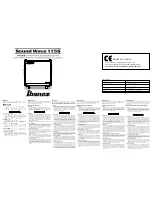
3
For the current sensor to read correctly, all of the current that passes through the
load must return through the black terminal. For this reason, loads that have a
ground connection will not allow reliable current measurements. In particular, do
not use a simple 10 V Voltage Probe (order code VP-BTA) with the Current
Sensor, because the Voltage Probe will ground part of the circuit. Instead, use a
Differential Voltage Probe (order code DVP-BTA).
Troubleshooting
For troubleshooting and FAQs, see
Accessories/Replacements
Item
Order Code
FGEN-PAMP
PAAS-PAMP
Repair Information
If you have watched the related product video(s), followed the troubleshooting
steps, and are still having trouble with your Power Amplifier , contact Vernier
Technical Support at [email protected] or call 888-837-6437. Support
specialists will work with you to determine if the unit needs to be sent in for
repair. At that time, a Return Merchandise Authorization (RMA) number will be
issued and instructions will be communicated on how to return the unit for repair.
Warranty
Warranty information for this product can be found on the Support tab at
General warranty information can be found at
Disposal
When disposing of this electronic product, do not treat it as household waste. Its
disposal is subject to regulations that vary by country and region. This item should
be given to an applicable collection point for the recycling of electrical and
electronic equipment. By ensuring that this product is disposed of correctly, you
help prevent potential negative consequences on human health or on the
environment. The recycling of materials will help to conserve natural resources.
For more detailed information about recycling this product, contact your local city
office or your disposal service.
Battery recycling information is available at
Do not puncture or expose the battery to excessive heat or flame.
alongside an AC waveform. To block unwanted DC signals, add a 1 µF
non-polarized capacitor in series to the input.
Output Circuit
The Vernier Power Amplifier has an analog Class A/B push pull output section
that will drive currents up to 1 A at frequencies from DC to over 10 kHz. It has a
soft current limit, intended as a safety net. Do not connect the Power Amplifier to
a load that would require more than 1 A. Load current can be calculated by
dividing the output voltage by the resistance of the load or dividing the wattage of
the load by the operating voltage.
The output is bipolar but not differential or balanced. In other words, the black
terminal is at approximately zero volts and the red swings positive and negative. A
current sense resistor of 0.1 Ω is between the black terminal and true ground.
Grounding Concerns
The Power Amplifier is not grounded through the external power connections, so
any external voltage source applied to the black terminal will find its way back to
ground through the LabQuest or LabPro. This is not of any concern when driving
floating loads (a load with only two leads and each connected ONLY to the Power
Amplifier terminals.)
Despite the ungrounded output, take care when driving any load that is part of
another electrical system, such as a robotic device or computer peripheral. If you
have any doubts about ground loops, connect the black Power Amplifier terminal
to your system ground. The Power Amplifier current sensor may give false
readings with two ground paths but this connection method reduces the chances of
any damage to your LabQuest or LabPro. Running the LabQuest on battery power
(and not connected to a computer host) also reduces the chance of ground currents
returning through the LabQuest. Any time your LabQuest or LabPro unit is
connected to a computer with a USB cable it is connected to that computer’s
ground which, in turn, is probably grounded to the building’s power system
ground through the AC plug.
Stability
The Power Amplifier output section uses distributed feedback to achieve accuracy
and DC stability. The feedback circuits have been designed to be stable with a
wide range of loads but highly reactive loads with very low resistance may present
a high enough Q to incite oscillation. When driving reactive loads you should
always have at least a few ohms in series. This is also good protection against an
over-current condition.
Current Sensor Output
The Power Amplifier contains a current sensor that can be read by a LabQuest,
LabPro, SensorDAQ, or Go!Link. Connect the supplied BTA cable between the
Power Amplifier and the interface. When the Power Amplifier is turned on, the
current sensor will be detected by the data-collection software. The bandwidth of
the current sensor is not as high as the amplifier since it is a trade-off between
noise and several other factors.






















